Part 2: Forecast statement of service performance for each of the three years 2012/13, 2013/14, and 2014/15
Output class: Audit and assurance services
The main purpose of an annual audit is to provide independent assurance about the fair disclosure of the financial – and, in many instances, non-financial – information within annual reports. An audit involves a range of procedures, tests, and management and governance enquiries to support our audit opinion.
In carrying out annual audits, auditors may also make observations and/or recommend improvements to matters of effectiveness and efficiency, waste, probity, and financial prudence, in management reports to the governors and managers of public entities. We also use our annual audits to gather information and knowledge about public entities to assist us in advising Parliament and other stakeholders and to help determine the other work we do, such as in our performance audits, inquiries, and good practice guides.
In 2012/13, our annual audits and other assurance services are expected to account for 88% of our total expenditure. Most of the output class involves annual audits for public entities. Annual audits are required by statute. Other work carried out under this output class includes three-yearly audits of local authority long-term plans and various other assurance work that complements the annual audits of public entities.
We will consider several aspects of our theme Our future needs – is the public sector ready? during our annual audits and other assurance work in 2012/13. The information we gather will help to inform other parts of our work programme and our reporting, and will feed into planning for annual audits in 2013/14 and 2014/15.
Types of annual audit reporting
The audit report is one of the reports from the annual audit process and is addressed to the readers of the financial statements and (where applicable) the statement of service performance. It includes the audit opinion on whether the financial statements (and, where applicable, the performance information) fairly reflect the public entity's performance and financial position. If the financial statements fairly reflect the public entity's financial performance and position (and, where applicable, performance information), the auditor issues an audit report with an unmodified opinion. However, if the auditor identifies a material error or omission in the financial statements or performance information, the auditor issues an audit report with a modified opinion.
The management report is addressed to the governing body or the top management of public entities. It sets out any significant issues identified by the auditor during the audit and, where relevant, provides recommendations for improving the public entity's controls, systems, and processes.
If the public entity is subject to financial review by select committees, we report the results of its annual audit to responsible Ministers and select committees. The financial review report includes a grading for public entities, based on our assessment of their management control environment, and financial and service performance (where required), systems, and controls.
Our focus
In the next year, within our annual audit and assurance work, we will focus on:
- Implementing Ministry of Economic Development and External Reporting Board changes – We will continue to focus on making a positive contribution to the work of the Ministry of Economic Development and the External Reporting Board in setting and implementing accounting and auditing standards. In 2012/13, we will help to prepare public sector entities and our auditors to audit in an environment of new accounting standards. We will also implement a regime equivalent to the auditor regulation that is being introduced with effect from 1 July 2012 for private sector auditors. Auditor regulation relates only to issuer audits. Issuers are legal entities that develop, register, and sell securities for the purpose of financing their operations. Public sector issuer audits are excluded from the new regulation. However, the Auditor-General is required to implement an equivalence regime covering these audits.
- Performance information – We are phasing in the Auditor-General's revised auditing standard on reporting performance information. Although we currently apply the new standard on some of our public sector audits, we will apply it on all applicable audits for reporting periods beginning on or after 1 July 2013. We continue to work directly with public entities to help improve performance information and to enable auditors to apply the revised auditing standard to audits of performance information.
- Sharing sector knowledge – We will continue with our initiative to better share knowledge. The initiative consolidates and expands on our previous work to help us better understand and use our knowledge about individual public entities, various sectors, and the public sector as a whole. We expect the initiative to extend our ability to be flexible, agile, and adaptive in both the way we work and how we report.
The Vote estimate for the Audit and assurance services output class in 2012/13 is $69.018 million.
A summary of our current audit portfolio is shown in Figure 11. Our impacts and outputs for Audit and assurance services are summarised in Figure 12. Details of our measures and standards for this output class, and our previous performance, are shown in the pages after Figure 12.
Figure 11
Summary of our current audit portfolio
| Sector * | Total audits |
|---|---|
| Central government | |
| Government departments | 42 |
| State-owned enterprises | 103 |
| District health boards | 46 |
| Crown Research Institutes | 42 |
| Tertiary education institutions | 149 |
| Māori Trust Boards | 17 |
| Other entities** | 306 |
| Central government total | 705 |
| Local government | |
| Local authorities | 79 |
| Other Council organisations | 191 |
| Electricity line companies | 74 |
| Port and airports | 55 |
| Licensing trusts | 44 |
| Fish and game councils | 14 |
| Other entities | 247 |
| Local government total | 704 |
| Schools | 2510 |
| Total for all sectors | 3919 |
* In all of the sectors except government departments and local authorities, we have included any related subsidiaries within the total of the main entities.
** The "Other entities" group in the central government sector includes Rural Education Activity programmes, section 19 audits, "subsidiaries" of government departments, Crown entities not separately identified, Crown agents, and miscellaneous other central government entities.

Figure 12
Summary of impacts and outputs for Audit and assurance services
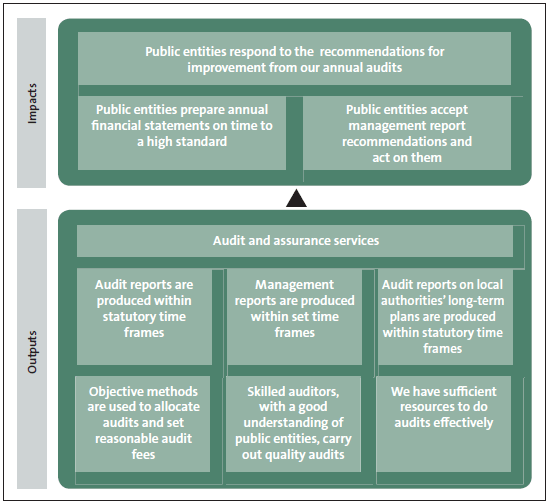
Impact and output measures and standards, and previous performance, for Audit and assurance services
Public entities respond to the recommendations for improvement from our annual audits
- Central government entities' management control environment, financial information, and service performance information systems and controls are improved (or at least maintained), measured against the previous two years.
As part of our annual audit work, we report to entities our observations on their management control environment (MCE), their financial information systems and controls on that system (FISC), and the quality of their service performance reporting, as well as the systems and controls underpinning it (SPIASC). Based on our observations, we issue recommendations for improvement and assign grades accordingly (i.e. Very Good, Good, Needs Improvement, or Poor).
By issuing our recommendations and grades, we aim to contribute to improved financial and non-financial performance reporting and, ultimately, improved performance management in public entities. The movements in the grades themselves provide an indication of the extent to which entities are accepting and responding to our recommendations, resulting in subsequent improvement. For the period of this Statement of Intent, we aim to see a continuing increase in Very Good/Good grades and a continuing decline in Needs Improvement/Poor grades.
Figure 13
Grades for management control environment (MCE), 2008/09, 2009/10, and 2010/11*
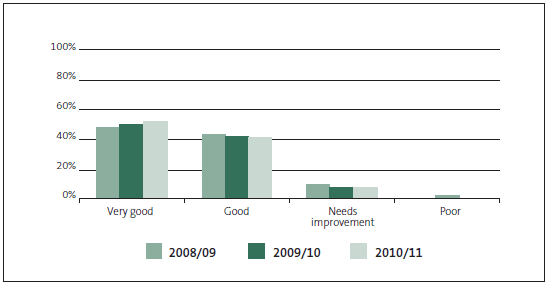
Figure 14
Grades for financial information systems and controls (FISC), 2008/09, 2009/10, and 2010/11*
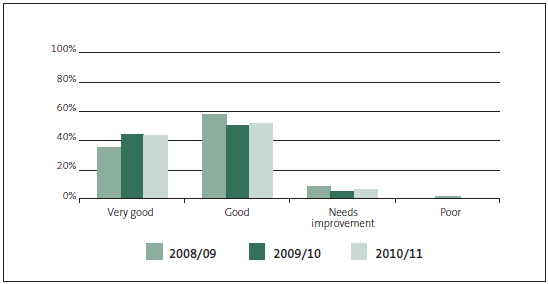
Figure 15
Grades for service performance information and associated systems and controls (SPIASC), 2008/09, 2009/10, and 2010/11*
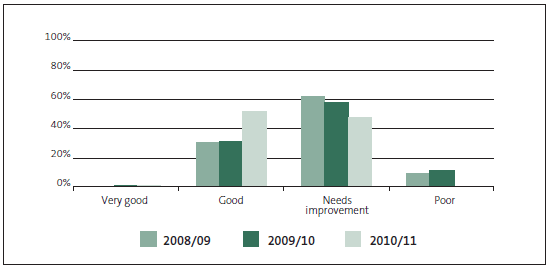
* Figures 13-15 show the year-end period for which the audit is carried out. The 2011/12 year audits and associated grades are completed during 2012/13.
Public entities prepare annual financial statements on time to a high standard
- The percentage of public entities' audited financial reports containing modified audit opinions is reduced (or at least maintained), measured against the previous two years.
Figure 16
Percentage of audited financial reports that contain modified audit opinions
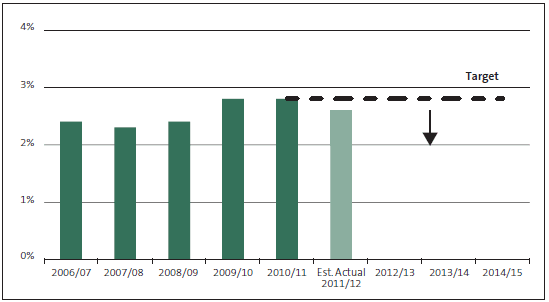
Public entities accept management report recommendations and act on them
- Public entities' acceptance of audit service providers' management report recommendations is improved (or at least maintained), measured against the previous two years. (Note: Before 2011, this has been assessed against only Audit New Zealand's management report recommendations.)
Figure 17
Percentage of management report recommendations accepted by public entities
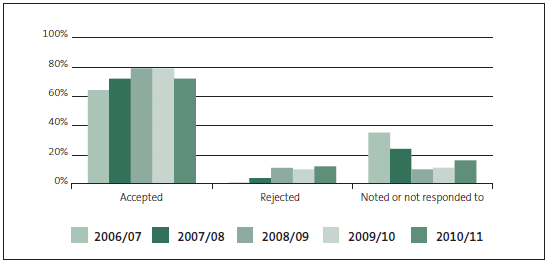
Audit reports are produced within statutory time frames
- The percentage of public entities' audited financial reports issued within the statutory time frame is improved (or at least maintained), measured against the previous two years.
Figure 18
Percentage of audits completed on time
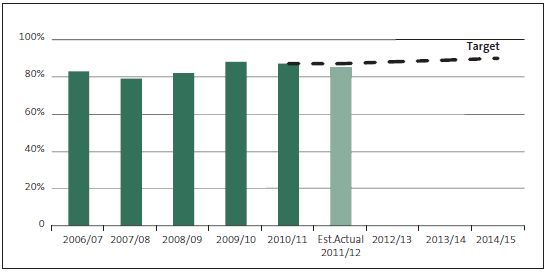
- Less than 30% of the outstanding audit reports at 30 June are because of inaction on our part.
Figure 19
Percentage of outstanding audit reports at 30 June because of our inaction
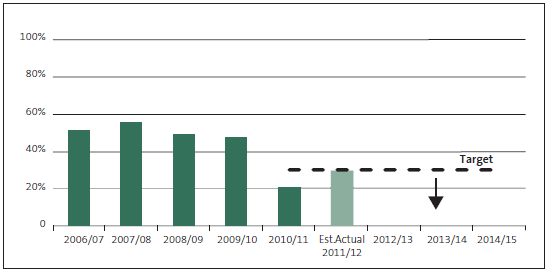
Management reports are produced within set time frames
- All management reports are issued within six weeks of issuing the audit report.
Figure 20
Percentage of management reports issued within six weeks
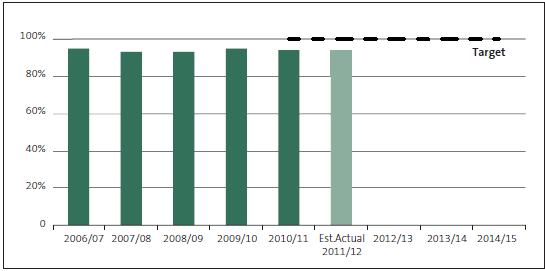
Audit reports on local authorities' long-term plans are produced within statutory time frames
- No outstanding long-term plan (LTP) audit opinions at 30 June of the year in which LTPs are to be adopted by local authorities are because of inaction on our part. All LTP management reports are issued within six weeks of issuing the LTP audit opinion. Long-term plan audits are carried out on a three-yearly basis. The last LTP audits were carried out in 2008/09, and the next opinions will be issued in 2011/12.
Results: In 2008/09, there were no outstanding audit opinions at 30 June as a result of inaction on our part. 85% of management reports were issued within six weeks of issuing the audit opinion.
Objective methods are used to allocate audits and set reasonable audit fees
- An annual independent review of our processes confirms the probity and objectivity of the methods and systems we use to allocate and tender audits, and monitor the reasonableness of audit fees.
Result: The review was carried out in 2010/11, and it confirmed that we achieved our forecast standard.
Skilled auditors, with a good understanding of public entities, carry out quality audits
- Client satisfaction survey results show that, overall, 85% of respondents are satisfied with the quality of audit work (including the expertise of staff and the quality of the public entity's relationship with their audit service provider).
Figure 21
Percentage of clients satisfied with the quality of audit work

- Quality assurance reviews for all appointed auditors are completed during a three-year period. Of the auditors reviewed in any given year, 100% achieve a grade of satisfactory or better.
Figure 22
Percentage of auditors achieving a grade of satisfactory or better from quality assurance reviews

We have sufficient resources to do audits effectively
- The Officers of Parliament Committee accepts any significant proposals for an appropriation increase in audit fees and expenses.
Result: 2008, 2010, and 2011 – No significant proposal was made for an appropriation increase in audit fees and expenses.
Output class: Supporting accountability to Parliament
Parliamentary services
Through our services to Parliament, we provide advice and assistance to select committees, Ministers, and individual members of Parliament, as well as to central agencies and other public sector representative groups, to assist them in their work to improve the performance and accountability of public entities.
The main ways in which we provide this advice and assistance is through:
- reports and advice to select committees to assist their financial reviews of government departments and Offices of Parliament, State-owned enterprises, and some Crown entities;
- reports and advice to select committees to assist their examination of the Estimates of Appropriations; and
- reports to responsible Ministers on the results of the annual audits.
We will use our 2012/13 theme Our future needs – is the public sector ready? to focus and inform our reports and advice to Parliament.
We also provide advice and assistance through:
- reports to Parliament and other constituencies on matters arising from our annual audits (including at least two reports to Parliament on the results of our audits in central and local government);
- responding to requests and participating in working parties on matters related to financial management and accountability with other stakeholders, including government departments, central agencies, local authorities, professional bodies, sector organisations, and other public entities; and
- working with Auditors-General in other countries to encourage, promote, and advance capability and co-operation in the field of public audit. This includes our role as Secretariat of the Pacific Association of Supreme Audit Institutions, being a member of various committees of the International Organisation of Supreme Audit Institutions, and being executing agent for the Pacific Regional Audit Initiative (funded by the Asian Development Bank, with co-financing from the Japan Special Fund and the Governments of New Zealand and Australia).
The Controller function
The Controller function of the Controller and Auditor-General provides independent assurance to Parliament that expenses and capital expenditure of government departments and Offices of Parliament have been incurred for purposes that are lawful and within the scope, amount, and period of the appropriation or other authority.
The OAG and appointed auditors carry out standard procedures to give effect to the Controller function in keeping with the Auditor-General's auditing standards and a Memorandum of Understanding with the Treasury. This involves reviewing monthly reports provided by the Treasury, and advising the Treasury of any issues arising and the action to be taken.
Each year, we report to Parliament on the significant issues arising from the operation of the Controller function.
Our focus
In Supporting accountability to Parliament in 2012/13, we will focus on:
- How well prepared the public sector is to meet our future needs – We will report to Parliament on the quality of the information about future needs of New Zealanders provided by entities and how the entities intend to address those needs.
- Performance information – We will continue to provide advice to parliamentary select committees on how to use performance information from government departments and Crown entities to assess and enquire into effectiveness and efficiency, particularly in a cost-constrained environment. We will also continue to liaise with government departments and Crown entities to help them improve their performance information and use it to consider effectiveness and efficiency.
- Sharing sector knowledge – We will make further progress on the better use and presentation of information about sectors within the public sector to Parliament, select committees, and public entities.
In addition, we will continue to support good governance and accountability in the Pacific through our role as Secretariat of the Pacific Association of Supreme Audit Institutions (PASAI) and through the Auditor-General's representation of the PASAI region on the governing board of the International Organisation of Supreme Audit Institutions (INTOSAI).
The Vote estimate for the Supporting accountability to Parliament output class in 2012/13 is $2.685 million.
Our impacts and outputs for Supporting accountability to Parliament are summarised in Figure 23. Details of our measures and standards for this output class, and our previous performance, are shown in the pages after Figure 23.

Figure 23
Summary of impacts and outputs for Supporting accountability to Parliament
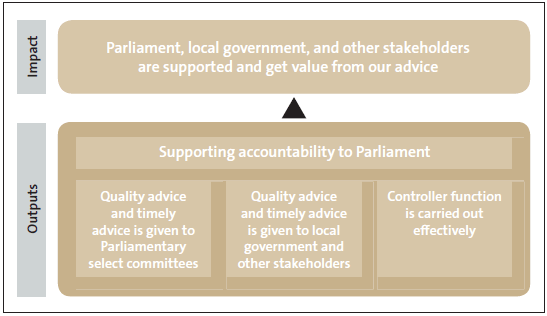
Impact and output measures and standards, and previous performance, for Supporting accountability to Parliament
Parliament, local government, and other stakeholders are supported and get value from our advice
- At least 85% of select committee members confirm that our advice assists them in Estimates of Appropriation and financial review examinations.
Figure 24
Percentage of select committee members who confirmed that our advice assists them in Estimates of Appropriations and financial review examinations
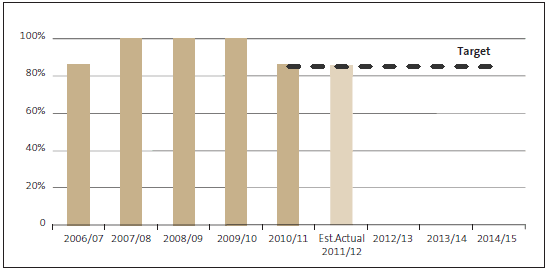
- At least 85% of other stakeholders we survey rate the advice they receive from us as 4 or better on a scale of 1 to 5 for relevance and usefulness.
Figure 25
Percentage of other stakeholders who rated our advice as 4 or better on a scale of 1 to 5 for relevance and usefulness
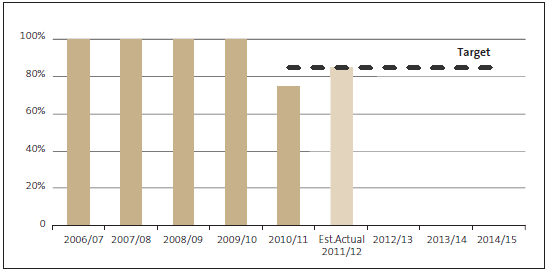
Quality advice and timely advice is given to Parliamentary select committees
- At least 85% of select committee members we survey rate the advice they receive from us as 4 or better on a scale of 1 to 5 for quality and usefulness.
Figure 26
Percentage of select committee members who rated our advice as 4 or better on a scale of 1 to 5 for quality and usefulness
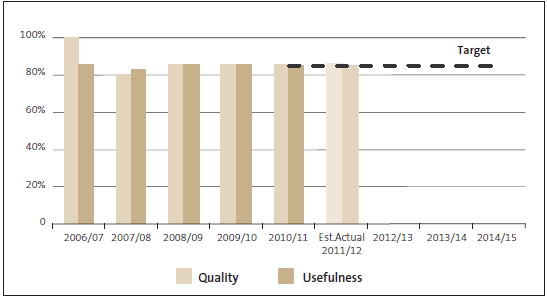
- Reports and advice are given to select committees and Ministers at least two days before an examination, unless otherwise agreed.
Figure 27
Percentage of reports and advice given to select committees and Ministers at least two days before an examination, unless otherwise agreed
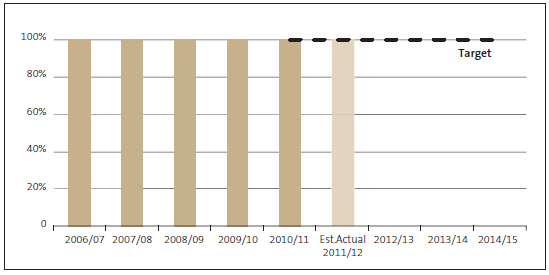
- An internal review of a sample of financial review, Estimates of Appropriations, and Ministerial reports confirms that they meet relevant standards and procedures, including that reports are consistent in their framework and approach, and are peer-reviewed in draft. (The nature, extent, and frequency of the quality assurance review are based on risk. The review is carried out during a three-year period.)
Results: A review in June 2011 confirmed that the appropriate systems are in place and they operate effectively. 2009 and 2010 – There was no internal review in these years. 2008 – Confirmed by an internal review of a sample of reports.
Controller function is carried out effectively
- Internal quality assurance is carried out to gain assurance that our policies, procedures, and standards for the Controller function have been applied appropriately. (The nature, extent, and frequency of the quality assurance review are based on risk. The review is carried out during a three-year period.)
Results: 2011/12: An internal review is in progress and expected to be completed in May 2012. No internal review was carried out in 2010/11. - Monthly statements provided by the Treasury are reviewed for the period September to June inclusive.* Advice of issues arising and action to be taken is provided to the Treasury and appointed auditors within five working days of receipt of the statement.
Results: 2006 to 2011: All monthly procedures were followed and agreed time frames achieved.
*This action is based on the requirement in section 65Y of the Public Finance Act 1989 for the Treasury to submit reports to the Auditor-General following the preparation (under section 31A) of financial statements of the Government "after the end of each month (except for the first two months and the last month) in each financial year".
Output class: Performance audits and inquiries
The Public Audit Act 2001 provides the Auditor-General with discretion to carry out performance audits to look at:
- the extent to which activities are carried out effectively and efficiently;
- compliance with statutory obligations;
- any act or omission that result or may result in waste; and/or
- any act or omission showing or appearing to show a lack of probity or financial prudence by a public entity or its members, office holders, or employees.
The Act also gives the Auditor-General the ability to inquire into any matter concerning a public entity's use of its resources. The Auditor-General can carry out inquiries either on request (for example, when correspondence from the public draws attention to potential issues) or on her own initiative.
Our inquiry work is largely reactive to issues of public concern. Each year, we usually receive:
- 200 to 300 external requests for inquiries; and
- 50 to 100 enquiries under the Local Authorities (Members' Interests) Act 1968.
The Auditor-General must also respond to requests for approvals about pecuniary interest questions regulated by the Local Authorities (Members' Interests) Act.
Our performance audit and inquiry work allows the Auditor-General to consider and provide advice about the above matters in greater depth than is appropriate within the statutory scope of an annual audit. Each year, we publish some 20 or more reports on performance audits, major inquiries, and other studies. We also publish reports on the results of annual audits for the central and local government sectors.
Our focus
Through our performance audits, we will focus on our theme Our future needs – is the public sector ready?, looking at specific questions that people tell us are important parts of the future they want. These questions will cover areas such as education services for Māori children, child health needs, and the implications of our ageing population.
The Vote estimate for the Performance audits and inquiries output class in 2012/13 is $6.587 million.
Our impacts and outputs for Performance audits and inquiries are summarised in Figure 28. Details of our measures and standards for this output class, and our previous performance, are shown in the pages after Figure 28.

Figure 28
Summary of impacts and outputs for Performance audits and inquiries
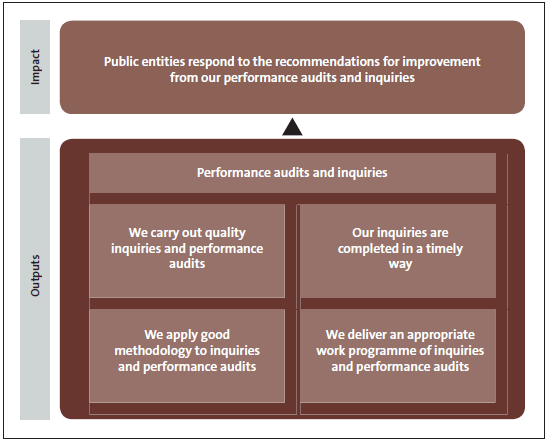
Impact and output measures and standards, and previous performance, for Performance audits and inquiries
Public entities respond to the recommendations for improvement from our performance audits and inquiries
- Entities accept or respond to the recommendations made in our performance audits. Each year, we review how entities have responded to a selection of our reports and present the results to Parliament in our annual follow-up report.
Results: 2010/11 – In April 2011, we reported to Parliament on how well five public entities implemented our recommendations. The entities had generally accepted our recommendations, but progress in implementing them had been faster for some recommendations than others. For those entities, and for other public entities, communicating results is an ongoing challenge.
A selection of our performance audit reports were reviewed each year from 2006 to 2010, and the results were presented to the Officers of Parliament Committee. The reviews concluded that our recommendations had been accepted by the relevant public entities and either had been implemented or were being implemented. - Entities take action in response to concerns identified in inquiry reports, as assessed by follow-up on a sample of sensitive and major inquiries carried out in the previous year.
Results: 2011 – We followed up on three inquiries. In all cases, the entities accepted our comments and took action to address the concerns. 2010 – We followed up on four of our 13 inquiries within these categories from the previous year that contained recommendations or suggestions for action. There was a high acceptance of our views and comments, which were contributing to significant change. 2009 – We followed up on four of the 11 inquiries within these categories from the previous year that contained recommendations or suggestions for action. In all instances, we were satisfied with the action taken.
We carry out quality inquiries and performance audits
- We complete 19 to 21 reports on matters arising from performance audits and other studies, and inquiries.
Figure 29
Completed reports on matters arising from performance audits and other studies, and inquiries
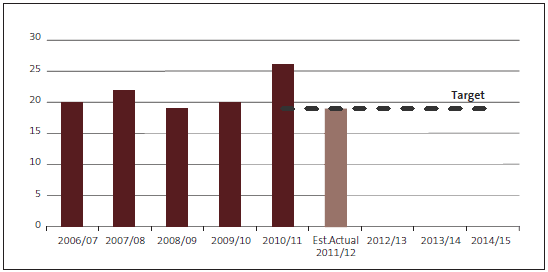
- Each year, independent reviews of two performance audits are carried out. These reviews confirm the quality of the reports in terms of the presentation of administrative and management context, report structure, presentation, and format (including use of graphics and statistics), and the reasonableness of the methodology used and the resulting conclusions and recommendations.
Results: 2010/11 – Two of our reports were independently reviewed by a panel of reviewers used by the Australasian Council of Auditors-General (ACAG) and two New Zealand reviewers. Overall, the reviewers' ratings showed that one report was rated higher than reports from other audit offices that the ACAG panel had reviewed during the past three years, and higher than the average for our reports reviewed during the past three years. The other report was rated below the average for reports from other offices and below the average score for our reports.
2007 to 2010 – Independent reviews of two performance audits confirmed the quality of reports and provided feedback on areas for us to improve. - At least 85% of the stakeholders that we seek feedback from rate our performance audit reports (relevant to their sector or interest) as 4 or better on a scale of 1 to 5 for quality and usefulness.
Figure 30
Percentage of select committee, local government, and other stakeholders who are satisfied with the quality and usefulness of our performance audit reports
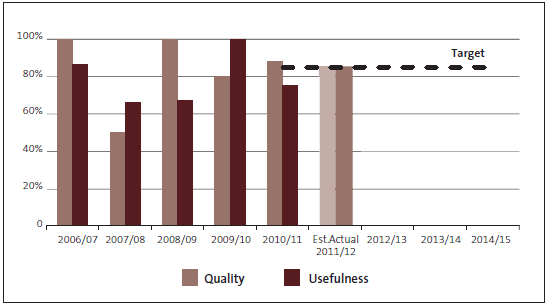
- Responses to requests for inquiries and our administering of the Local Authorities (Members' Interests) Act 1968 requests are in keeping with relevant policies, procedures, and standards, as confirmed by internal quality assurance review. (The nature, extent, and frequency of the quality assurance review are based on risk. The review is carried during a three-year period.)
Results: 2010/11 – Reviews were completed for both the general inquiries and Members' Interests inquiries systems, and confirmed that requests are carried out in keeping with relevant policies, procedures, and standards. No internal quality assurance review was done in 2008/09 or in 2009/10.
Our inquiries are completed in a timely way
- 80% of our findings on inquiries are reported to the relevant parties within:
- three months for routine inquiries;
- six months for significant inquiries; and
- 12 months for major inquiries.
Figure 31
Percentage of findings on routine inquiries reported to relevant parties within three months

Figure 32
Percentage of findings on significant inquiries reported to the relevant parties within six months
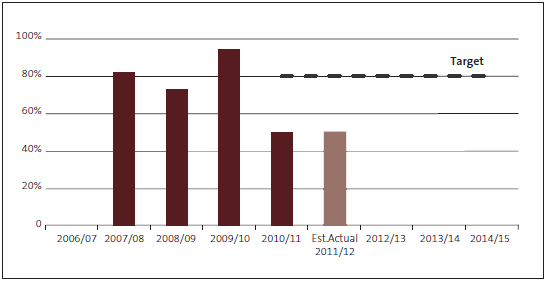
Results for major inquiries: 2008 – No major inquiries were carried out. 2009 – Two major inquiries; both reported within 13 months. 2010 – Five major inquiries; four reported within 12 months. 2011 – Three major inquiries; one reported within 12 months.
Our inquiries are completed in a timely way
- For enquiries under the Local Authorities (Members' Interests) Act 1968, we complete 90% of enquiries within 30 working days.
Figure 33
Percentage of enquiries under the Local Authorities (Members' Interests) Act 1968 completed within 30 working days
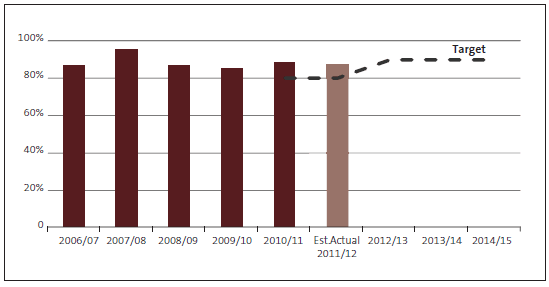
We apply good methodology to inquiries and performance audits
- Our performance audit methodology reflects good practice for carrying out such audits, as assessed every second year by the Australian National Audit Office.
Results: 2010/11 – The Australian National Audit Office (ANAO) reviewed two performance audits and found that they met most of the review criteria and were generally conducted in keeping with key OAG processes and practices.
2008/09 – The ANAO reviewed two performance audits and confirmed areas in which the quality of our reports is strong and noted areas for us to improve.
2006/07 – The ANAO reviewed two performance audits and endorsed the quality of the reports. - Internal quality assurance reviews on selected performance audit reports confirm that reports are prepared in keeping with the performance audit methodology. (The nature, extent, and frequency of the quality assurance review are based on risk. The review is carried out during a three-year period.)
Results: Internal review in 2010/11 confirmed that appropriate systems and controls are in place and that reports are prepared in keeping with the performance audit methodology. There was no internal review in 2008/09 or 2009/10.
Internal review in 2007/08 confirmed that appropriate systems and controls are in place and that reports are prepared in keeping with the performance audit methodology.
We deliver an appropriate work programme of inquiries and performance audits
- Select committees and other stakeholders are satisfied with the proposed work programme of performance audits (as indicated by feedback on our draft annual work programme.)
Results: 2011 – Feedback received from select committees and other stakeholders mainly supported our proposals and approach, with a specific suggestion that in future years we look at the performance of the New Zealand Police in road safety enforcement. 2007 to 2010 – Feedback received from select committees and other stakeholders mainly supported our proposals and approach.
